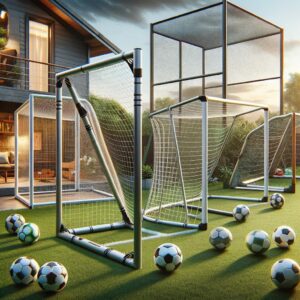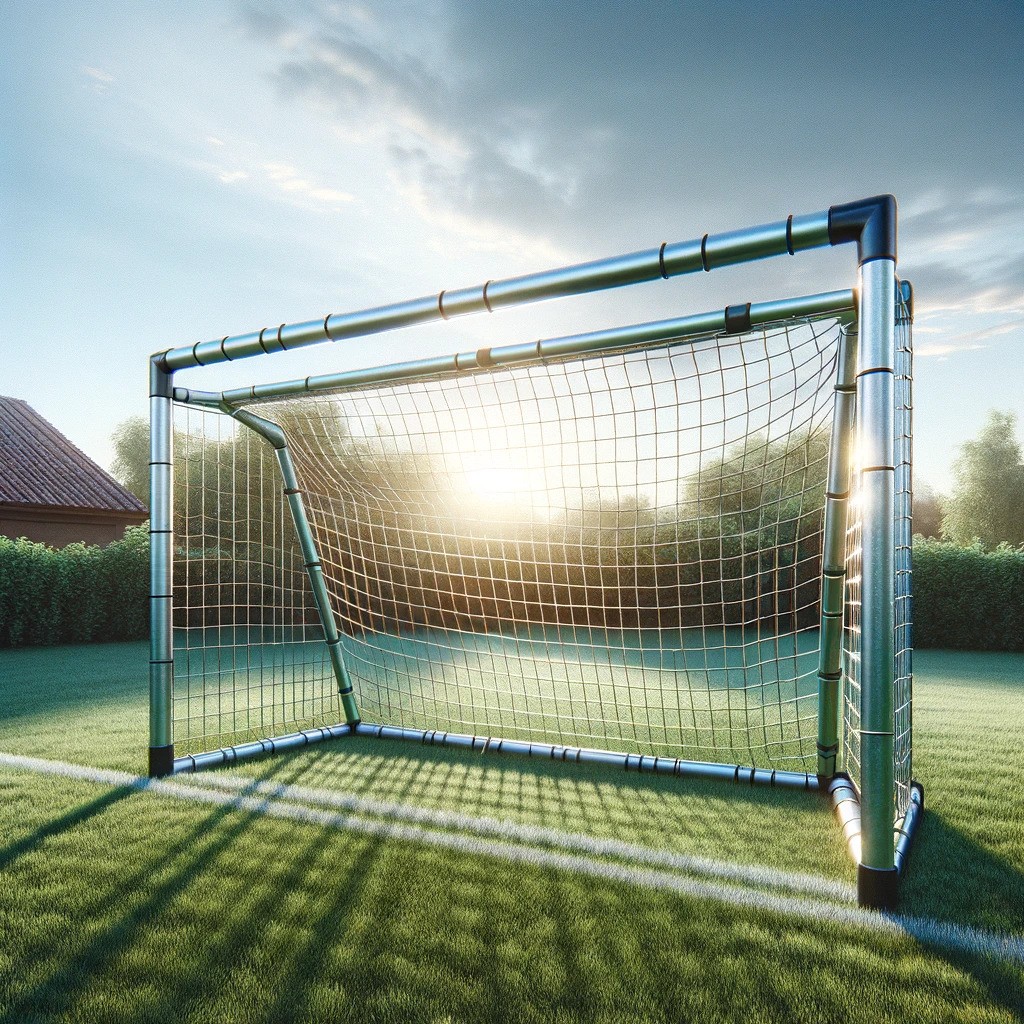Have you ever dreamed of scoring that perfect goal in your own backyard? For soccer enthusiasts and aspiring players, having a full-size soccer goal at home is more than just a luxury; it’s a step towards honing skills, enjoying a great sport, and staying active. A full-size soccer goal in your home environment brings the thrill of the game closer to you. It offers a unique opportunity to practice like a pro, anytime you desire. Whether it’s for training, leisure, or simply for the love of the game, understanding the essentials of a full-size soccer goal for home use is crucial.
What to Consider When Choosing a Full-Size Soccer Goal
When selecting the perfect full-size soccer goal for your home, there are several key factors to consider to ensure you get the best value and enjoyment from your purchase.
- Material and Durability
The material of the soccer goal is vital for its durability and longevity. Goals made of PVC are lightweight and ideal for casual play, while aluminum goals offer greater strength and weather resistance, perfect for a more serious player.
- Size and Dimension Compliance
A standard full-size soccer goal measures 24 feet wide and 8 feet high. Ensure that the goal you choose complies with these dimensions, especially if you’re training for competitive matches. This compliance not only improves your training but also gives you an authentic game experience.
- Portability and Storage
Consider the space where you will set up the goal. If you have limited space or need to move the goal frequently, look for portable options that are easy to dismantle and store.
- Ease of Assembly
You don’t want to spend all day setting up or taking down your soccer goal. Opt for a model that is straightforward to assemble, with clear instructions and manageable parts.
- Price Range
Soccer goals vary in price, so it’s important to set a budget. While more expensive models often offer higher quality and durability, there are also many affordable options that do not compromise too much on quality.
Top Picks for Full-Size Soccer Goals for Home

High-End Option
For those who want the best, high-end soccer goals often feature robust frames, professional-grade nets, and superior durability. They are designed to withstand intense play and harsh weather conditions.
Budget-Friendly Choice
If you’re looking for something more affordable, there are many budget-friendly options that still offer decent quality. These goals are usually made of lighter materials and are perfect for casual play.
Best for Durability
Durability should be a top priority, especially if you plan to use your goal extensively. Look for goals made with high-grade materials like reinforced aluminum or steel, designed to endure rough play and all weather conditions.
Most Portable Option
If portability is your main concern, there are goals designed for easy transport and storage. These goals typically feature a foldable design and are made with lightweight materials, making them perfect for moving around as needed.
Installation Tips for Full-Size Soccer Goals
Proper installation of your full-size soccer goal is essential for both safety and functionality. Here’s a detailed guide to ensure a smooth and secure setup:
Preparing the Area:
- Location: Choose a level and spacious area in your yard. Ensure there’s enough clearance around the goal for safe play.
- Surface: The ideal surface is grass, but you can install the goal on various surfaces, including artificial turf. Avoid uneven or hard surfaces that could affect stability.
- Measurements: Double-check the dimensions of your space. There should be ample room not only for the goal itself but also for a buffer zone around it.
Step-by-Step Installation Process:
- Unpacking: Carefully unpack all components. Lay them out and check against the provided inventory list to ensure no parts are missing.
- Frame Assembly: Start by assembling the frame. Depending on your model, this may involve connecting tubes or snapping together parts. Always refer to the specific instructions for your goal.
- Net Attachment: Once the frame is assembled, attach the net. Start at the top corners and work your way down, ensuring the net is taut and evenly distributed.
- Anchoring the Goal: Securely anchor the goal to the ground. If you’re on grass, use stakes or ground anchors. For harder surfaces, sandbags or weights might be necessary to ensure stability.
- Final Checks: After installation, inspect the goal to make sure all parts are secure and there are no loose ends that could pose a safety hazard.
Safety Considerations:
- Regular Inspection: Regularly check the goal for any loose parts, corrosion, or wear and tear. Pay particular attention to the net and its attachments.
- Stability: Always ensure the goal is stable and securely anchored before each use. If you notice any wobbling or instability, cease use immediately and rectify the issue.
- Weather Awareness: Be mindful of weather conditions. In high winds or severe weather, it’s advisable to take down portable goals to prevent damage or accidents.
Additional Tips:
- Tools and Assistance: Have the necessary tools at hand before you start the installation. It’s also helpful to have an extra pair of hands, so consider asking a friend or family member to assist.
- Time Allocation: Don’t rush the installation. Allocate enough time to carefully complete each step.
- Safety Gear: Use gloves to protect your hands, especially when handling metal goals or tight net fixings.
Maintenance and Care of Soccer Goals
Maintaining your soccer goal is essential to ensure its longevity and safe use. Here’s a more detailed look at how to care for your soccer goal effectively:
Routine Checks:
- Frequency: Regularly inspect your soccer goal, ideally every month, or more often if it’s used frequently.
- Structural Integrity: Check for any signs of structural weakness or damage such as rust on metal goals, cracking in PVC frames, or bends and dents in the posts.
- Net Inspection: Examine the net for any tears, holes, or fraying. Pay close attention to the attachment points, as these are areas that often bear the most stress.
- Hardware: Ensure all fastenings, screws, and bolts are tight and secure. Loose hardware can lead to instability and potential accidents.
- Anchoring System: Check the anchoring system, whether it’s ground stakes, weights, or another method, to ensure the goal remains firmly in place.
Cleaning and Storage Tips:
- Regular Cleaning: Wipe down the frame and net with a damp cloth to remove dirt and debris. For tougher stains, use a mild soap solution.
- Avoid Harsh Chemicals: Do not use harsh chemicals or abrasive cleaners, as these can damage the material of the goal.
- Drying: After cleaning, ensure the goal is completely dry before storing to prevent mold and rust.
- Storage Location: Store the goal in a cool, dry place when not in use, especially during extreme weather conditions like heavy rain, snow, or intense sun.
- Disassembly: For long-term storage, consider disassembling the goal to save space and protect it from environmental factors.
Longevity Tips:
- Prevent Misuse: Discourage climbing on the goal or hanging from the crossbar, as this can cause damage and poses a safety risk.
- Replacement Parts: Replace any worn or damaged parts promptly. This not only extends the life of the goal but also ensures safety.
- Weather Consideration: If your goal is in an area with harsh weather conditions, consider additional protective measures like covers or moving it to a sheltered area.
Additional Care for Different Types of Goals:
- Metal Goals: For metal goals, check for rust or corrosion. Treat any rust spots immediately to prevent spreading.
- PVC Goals: PVC goals are prone to becoming brittle in cold weather. In colder climates, consider storing these goals indoors during winter.
- Portable Goals: Portable goals often have more moving parts. Regularly check these components for wear and ensure they are functioning correctly.
Benefits of Playing Soccer at Home
Playing soccer at home offers a range of benefits, both physical and mental.
Physical Health Benefits: Regularly playing soccer improves cardiovascular health, builds muscle strength, enhances flexibility, and improves coordination. It’s a full-body workout that boosts overall fitness.
Mental Health Benefits: Soccer is not just good for the body; it’s also great for the mind. It can reduce stress, improve mood, and enhance cognitive functions. Playing soccer at home offers a convenient way to unwind and engage in a fun, fulfilling activity.
Family and Community Engagement: Having a soccer goal at home encourages family bonding and community interaction. It’s a great way for families to spend quality time together and for friends to engage in healthy competition.
Conclusion
Investing in a full-size soccer goal for your home can be a game-changer for soccer enthusiasts of all levels. It’s an excellent way to improve your skills, stay fit, and enjoy the beautiful game right in your backyard. Remember to consider the key factors like material, size, portability, ease of assembly, and price when choosing your goal. With proper care and maintenance, your soccer goal can provide years of enjoyment.
Frequently Asked Questions
What is a full size professional football goal?
A full size professional football goal, ideal for competitive matches and professional training, measures 24 feet in width and 8 feet in height.
What is an official soccer goal size?
The official soccer goal size, as per standard regulations, is 7.32 meters (8 yards) in width between the inside of the posts, and 2.44 meters (8 feet) in height from the lower edge of the crossbar to the ground.
How much does a soccer goal cost?
The price of a soccer goal varies widely, ranging from $30 to $5,000. For a quality soccer goal suitable for backyard use, you can expect to pay between $200 and $600. Smaller, portable soccer goals are more affordable, often costing up to $100.
What shape is a soccer goal?
A soccer goal is typically composed of two vertical posts joined at the top by a horizontal crossbar. The posts and crossbar can be square, rectangular, round, or elliptical in shape and are made from approved, safe materials.
How much do metal soccer goals weigh?
Metal soccer goals, primarily used in movable setups, generally weigh between 150 and 500 pounds, depending on their size and construction.
How far apart are soccer goals in feet?
In standard play, soccer goals are placed 14 feet apart (inside measurement) on the center of each goal line within the perimeter wall.
What is the regulation width of a soccer goal?
The regulation width for a soccer goal is 9 feet 10 inches (3 meters) wide, commonly used in various formats of the game.
What is the standard height of a soccer goal?
The standard height for traditional 5-a-side soccer goals is typically either 12 feet wide by 4 feet high or 16 feet wide by 4 feet high, used on various pitches including 3G, AstroTurf, and indoor facilities.

